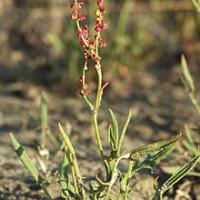Docks
Rumex acetosella
Rumex acetosella, commonly known as sheep sorrel, is a perennial herbaceous plant belonging to the buckwheat family, Polygonaceae. Here's a detailed description:
Botanical Description:
-
Habit:
- Sheep sorrel is a low-growing perennial herb with a distinctive appearance.
-
Leaves:
- The leaves are arrow-shaped or lanceolate with a characteristic arrowhead at the base. They are often folded along the midrib, giving them a "V" shape.
- The leaves have a sour or tangy taste, attributed to oxalic acid.
-
Stems:
- The stems are slender, reddish or green, and may sprawl or stand upright.
-
Inflorescence:
- The flowers are arranged in slender, terminal racemes (flower clusters).
-
Flowers:
- The small, greenish to reddish-brown flowers are not particularly showy. Each flower has six tepals, which are similar in appearance to petals.
-
Fruit:
- The fruit is a small, triangular nutlet.
Identification Tips:
-
Arrow-shaped Leaves:
- The distinctive arrow-shaped leaves, often folded along the midrib, are a key identification feature.
-
Sour Taste:
- The leaves have a sour or tangy taste due to the presence of oxalic acid.
-
Slender Racemes:
- Look for the slender racemes of flowers at the tips of the stems.
Habitat:
-
Distribution:
- Sheep sorrel is widespread and can be found in various regions around the world.
-
Habitat:
- It thrives in open, sunny areas, including meadows, grasslands, and disturbed sites.
Ecological Role:
- Wildlife Interaction:
- Sheep sorrel provides food for various herbivores, and its seeds are dispersed by animals.
Culinary and Medicinal Uses:
-
Edibility:
- The leaves have been used as a culinary ingredient, often added to salads or used as a seasoning due to their tangy flavor.
-
Traditional Medicine:
- In traditional medicine, sheep sorrel has been used for its potential diuretic and laxative properties.
Management and Control:
-
Cultural Practices:
- Regular mowing can help control the height of sheep sorrel and prevent it from producing seeds.
-
Manual Removal:
- Hand-pulling or hoeing can be effective for small infestations, but it's essential to remove the entire plant to prevent regrowth.
-
Herbicides:
- Selective herbicides labeled for use on broadleaf weeds can be used in areas where control is necessary. Always follow recommended application rates and guidelines.
-
Improving Soil Fertility:
- Sheep sorrel often thrives in acidic soils, so liming to raise the soil pH may help reduce its prevalence.








